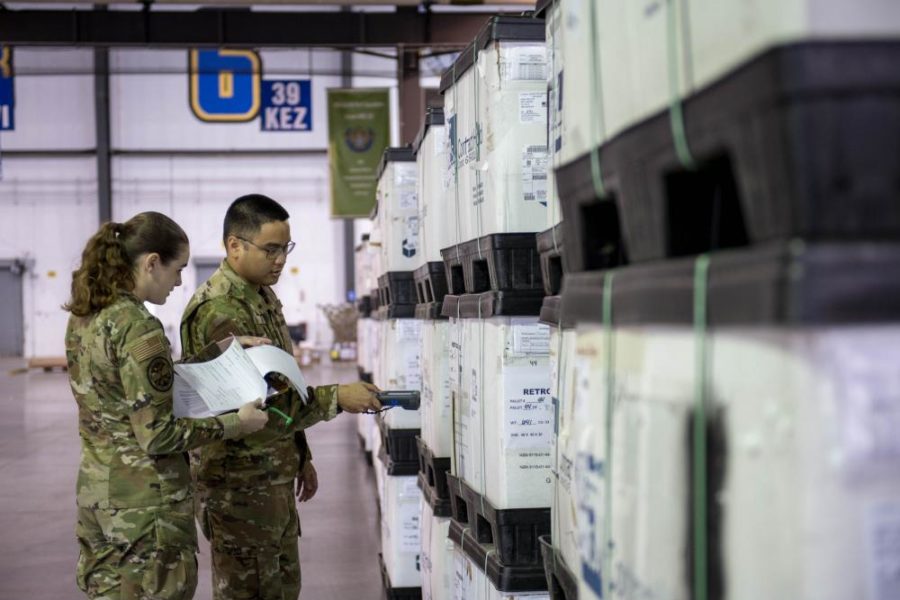Roughly eight to 10 flights full of supplies and equipment for Ukraine are landing in Eastern Europe every day, Pentagon press secretary John F. Kirby told reporters on April 12, as the U.S. and other nations race to get their aid packages into the hands of Ukrainians combatting Russia’s invasion.
“There’s more than 30 other nations contributing various amounts of material—some weapons, some not, some a mix, and we are helping coordinate the deliveries into Ukraine of all that material, not just ours, but of others at various trans-shipment sites in the region,” Kirby said during a briefing hosted by the State Department’s Brussels Media Hub. “And that flow continues.”
All told, more than two dozen countries ranging from Japan to Canada to North Macedonia have pledged to send billions of dollars worth of military equipment to Ukraine, presenting a daunting logistical challenge as those nations look to deliver that equipment at speed.
It’s an issue that U.S. Transportation Command boss Gen. Jacqueline D. Van Ovost addressed several times at the end of March when appearing before Congress.
“We work very closely with European Command as they integrate with Ukraine and prioritize the needs of Ukraine, so that we are able to ship and get [material] close to Ukraine and onward-moved very quickly, as we manage not only the nodes or the airports and seaports to get stuff there, but the people that work there and the flow in,” Van Ovost said during a House Armed Services subcommittee hearing.
In a Senate hearing, Gen. Tod D. Wolters, head of U.S. European Command, praised TRANSCOM for delivering “miracles at the point of need” in the Ukraine-Russia war. Similarly, Kirby touted the Defense Department’s ability to track, ship, and deliver aid.
“There’s roughly eight to 10 flights a day coming in to these trans-shipment sites from all over the world. And that stuff is not sitting around in warehouses,” Kirby said. “We’re helping get it on pallets and helping it get on trucks and helping it get into Ukraine every single day.”
In mid-March, President Joe Biden authorized an $800 million package of defensive assistance for Ukraine, followed by another $100 million in early April. Kirby said on April 12 that the Pentagon expected those packages to be completed in a matter of days and delivered “by the middle of this month.”
Speaking during a Defense Writers Group event on April 12, Deputy Defense Secretary Kathleen Hicks said there are packages of U.S. military aid to Ukraine soon to be announced that will include longer-ranged weapons than have been provided so far. She did not name the weapons.
“Those are presidential decisions,” Hicks said of the new aid packages, and “I don’t want to get in front of those.” However, the Pentagon is “moving quickly” on weapons that would “provide a little more range and distance” than what has been given to date, and “you’ll see more in the coming days,” she told defense reporters.
The new weapons would be in addition to Javelin man-portable anti-tank weapons and Stinger shoulder-fired anti-aircraft weapons, Hicks said. She said Stingers and Javelins, as well as artillery rounds and “other ammunition” are “incredibly important” to Ukraine, noting, “We’ve moved a lot of that, and that will continue,” she said.
When asked if the U.S. would provide weapons that Ukraine could launch into Russia, Hicks said the U.S. is in continuing talks with Britain and 30 other countries about how best to provide “capability that the Ukrainians request” that sends “a clear signal, in terms of the U.S./Russian dynamic.”
Ukraine has requested aircraft, or a NATO-established no-fly zone over the country, as well as other weapons.
The U.S. is reviewing “a wide range of systems,” for Ukraine, she said. In addition to weapons and cash aid, the U.S. has been providing intelligence assistance to Ukraine, “which I would call ‘high-end’ help,” Hicks said.
The urgency to get that equipment into Ukraine fast has increased as Russia has begun to reposition its forces and focus its efforts on eastern Ukraine, raising fears that the war’s brutality could increase even more and become, in the words of one Pentagon official, a “knife fight.”
“We are mindful of the time,” Kirby acknowledged, noting the Pentagon has shortened the time it takes to actually get equipment into Ukrainian hands “down to between four to six days.”
Calling that speed “unprecedented” across his time in the Pentagon, Kirby did note that not all shipments have been that fast.
One of the most high-profile pieces of the U.S. defensive aid packages being sent is the batch of Switchblade drones—loitering munitions that are sometimes referred to as “kamikaze” drones. The Pentagon confirmed on April 6 that a small number of Ukrainian troops, already in the U.S. for professional military education, were being trained to operate the Switchblades, and on April 10, Defense Secretary Lloyd J. Austin III held a video call with those service members on the same day they were slated to return home.
“He … wanted to know [how] they felt the training went, and he was quite gratified to hear that they were pleased by what they were trained on, not just in terms of Switchblade, but other things,” Kirby said of Austin’s conversation with the Ukrainians. “So, we are continuing to try to get the Ukrainians the systems and the weapons that they need, that they’re using most effectively.”
